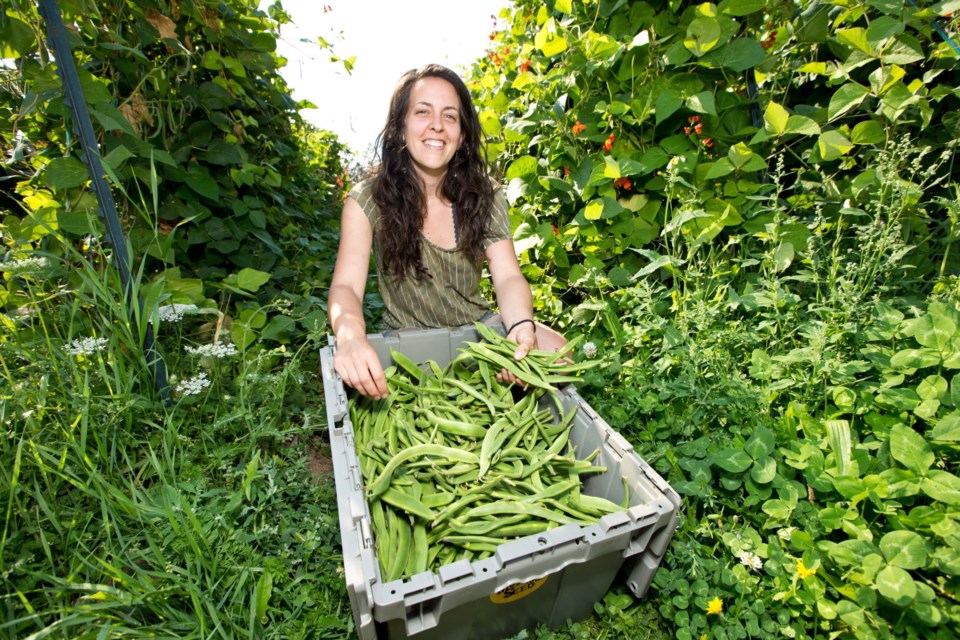Jesse Howardson picks a 10-inch bean from the vine in Saanichton, peeling it open to reveal bright red beans in its pod.
“They’re nice and tender now,” says the LifeCycles farm gleaning co-ordinator.
Scarlet runner beans are thriving at SunTrio Farm in Saanichton — the combined result of hot and dry growing conditions. But instead of going to market, Thursday’s harvest went directly to the Mustard Seed food bank.
It’s part of a pilot project seeking to bring fresh, local food to those who need it — food that might otherwise go to waste.
“It’s an exceptional year, with the heat and dryness, but there’s clearly a need for this,” Howardson says.
The farm gleaning project is just one of several initiatives that aims to expand the Greater Victoria Food Share Network, an effort to increase local food security. Another example is a food rescue project that would see extra produce from Thrifty Foods distributed to food banks.
The farm gleaning pilot is modelled in part on LifeCycles’ fruit tree project, which has been running for 18 years. Last season, the fruit tree project harvested 30,000 pounds of fruit from private properties, the bounty shared four ways among the homeowners, volunteers, food banks and community organizations.
In the farm gleaning project, which is being tested for three months, LifeCycles staff and volunteers collect excess produce from local farms. Three-quarters is sent to the food bank, while the rest is reserved for volunteers.
Since the Aug. 1 launch, Howardson estimates 4,000 pounds of produce, valued at $11,000, have been collected — including more than 2,000 pounds of blueberries, and between 150 and 200 pounds of peppers per week from a single farm.
There are many reasons a farmer might participate, Howardson says.
Bumper crops occur when there’s an overabundance of produce. Sometimes, there’s more than a farmer can sell, but it still needs to be harvested to keep the plants healthy, as is the case with blueberries.
“They might also call us if there’s some damage to the crop that makes it unmarketable, but it’s still edible food,” Howardson says, giving the example of leafy greens that have holes eaten out of them by slugs.
The Mustard Seed offers tax receipts to farmers who donate excess produce.
SunTrio manager Theresa Heinekey says the farm is offering zucchini, peppers and other produce that is getting spots and bruises on it but is still good to eat. The farm also planted more scarlet runner bean seeds this year, but stores are less interested in them than expected.
“They’re kind of a funny bean. They’re really good tasting but a little funny looking and not very well known,” she says. “People say, ‘Oh, if you had a normal string bean, we’d want it.’ ”
SunTrio has taken surplus produce to food banks in the past, but the new program makes it much easier. If it didn’t go to the food bank or to staff, it would be composted, Heinekey says.
“We’re not intentionally growing to give away, but food is for eating,” she says.
“It’s an awesome program and I imagine there’s a ton of farmers in the same situation as us who might want to participate.”
So far, six producers on the Saanich Peninsula are participating: SunTrio, Arbor Blueberry Farm, Saanich Organics, Longview Farms, Coastal Crops Organic Market Garden and Little Mountain Farm.
With current resources, staffing and volunteers, LifeCycles is about at capacity, Howardson says. But more volunteers are welcome.
“It’s really nice. Because of all those different reasons that a farmer might call, we get a really good diversity of food, so there’s a choice of fresh food going to the Mustard Seed,” Howardson says.
Rudi Wallace, director of food security at the Mustard Seed, says the produce collected from farms is distributed to families and individuals in food hampers, as well as prepared in meals at the food bank and frozen for times when the harvest is less abundant.
The Mustard Seed has a goal of making 30 per cent of each hamper fresh food. It is meeting or surpassing that goal now, but the test will come between November and April when food production and donations are down.
“In the non-profit world, things are often quite piecemeal. What’s happening with a more concerted effort is a broader food security strategy,” Wallace says, noting that individuals with more food security have lower health-care costs.
But while the farm gleaning project is a positive one, Wallace says it’s important to fight the root causes of food insecurity. Increasing the minimum wage, affordable housing opportunities and finding ways to reduce the cost of living would make it easier for families and individuals to afford nutritious, fresh food.
“While this is an amazing project, we really need to do more,” Wallace says. “We’re excited and pumped about it, but this is just the beginning.”



